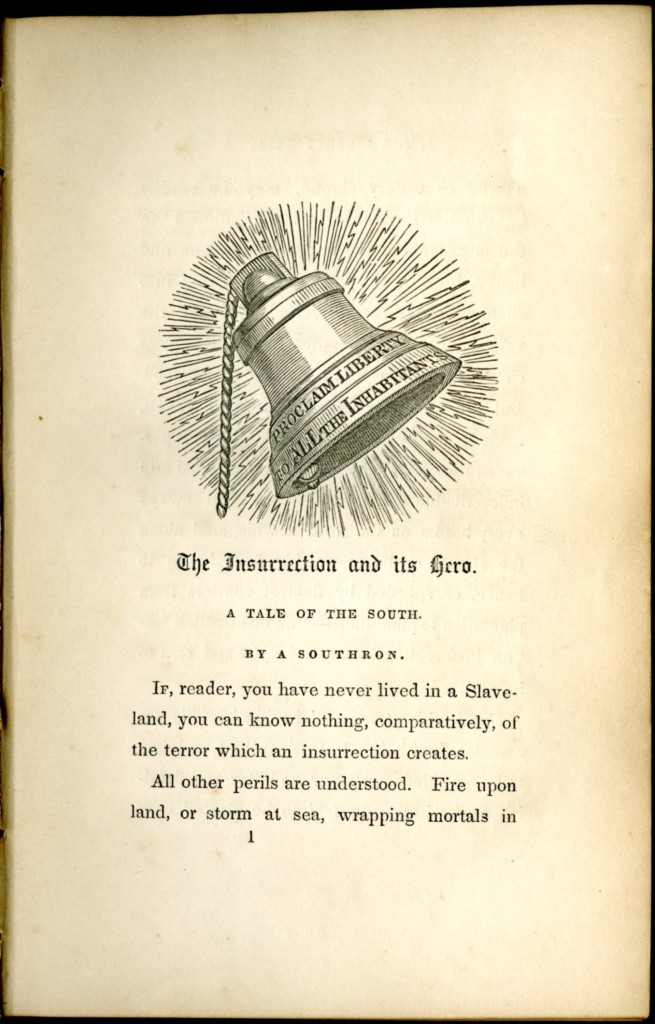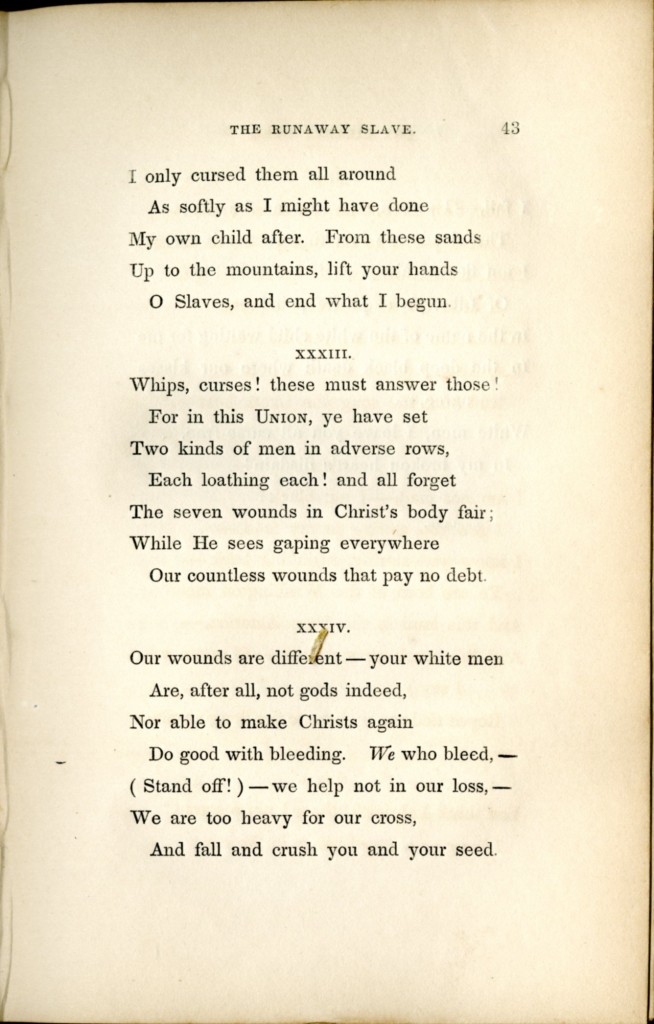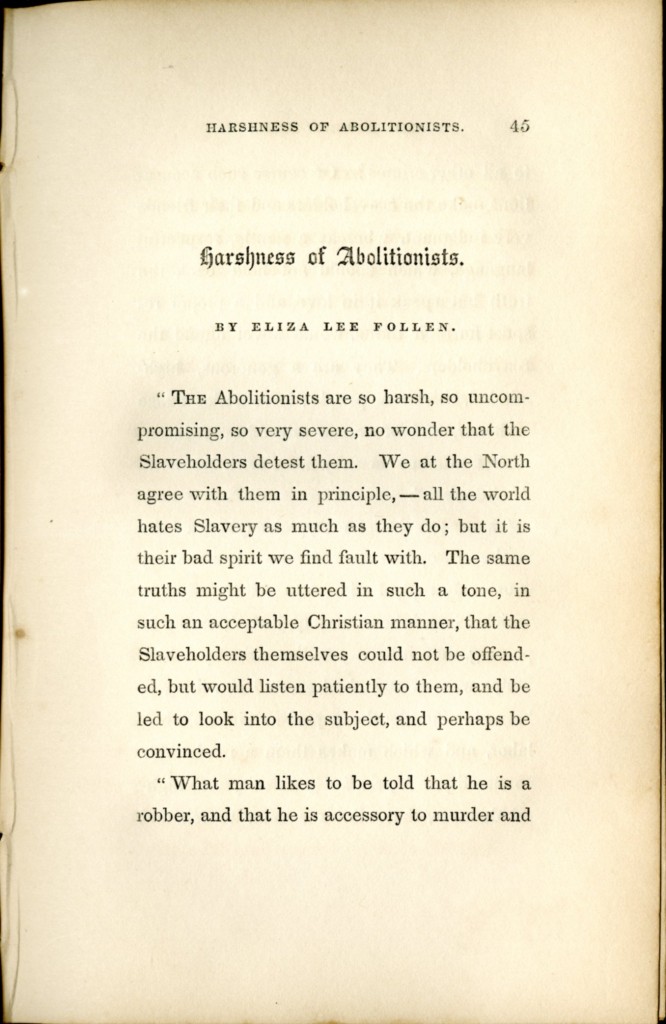The Liberty Bell. Boston: American Anti-Slavery Society, 1848 containing the first appearance of EBB’s “The Runaway Slave at Pilgrim’s Point” (ABLibrary Rare X 326 C4661 1848)
Rare Item Analysis: “The Runaway Slave at Pilgrim’s Point” in The Liberty Bell (1848)
by Bahar Saber
Elizabeth Barrett Browning is regarded as a profound poet of the Victorian era. Her poems continue to resonate very strongly with people because many of her poems offer social commentary to injustices of her day, and surprisingly some of these injustices persist today. Her poem, “The Runaway Slave at Pilgrim’s Point,” was written for the anti slavery annual, The Liberty Bell (1848). This American annual was sold at an anti slavery bazaar at Christmas from 1839-1858, and the proceeds from this book went to help fight slavery. This book can be found in the Armstrong Browning Library Rare Books collection, in the 19th Century Collection. This rare item shows that there were many intellectual people at the time working to disintegrate the institution of slavery. For almost twenty years, writers would contribute to this annual, and this rare item allows for people nowadays to see the injustices people of the past had to go through and how they worked to fight it.
The editor of The Liberty Bell, Maria Chapman, was impressed with Barrett Browning’s earlier works, especially “Cry of the Children” (1843). She saw EBB as a maverick of her generation, and since she was able to speak up against child slavery, Chapman wanted her to write a poem that would raise awareness about black slavery. Barrett Browning was heavily opposed to slavery because her family made their fortune through slavery in Jamaica, and this caused her to have intense guilt throughout her life. She was one of the few British writers asked to write in The Liberty Bell, and her poem was a poignant piece that some felt was genius, while later critics in the 1980s and 1990s felt was too harsh or out of place because she was a privileged white woman writing in the voice of a slave.
The placement of Browning’s poem is especially crucial in The Liberty Bell. It is placed second, right after an article called, “The Insurrection and its Hero.” This article tells the story of an unsuccessful slave revolution and the heroic slave who led it. This slave is named Isaac, and he tries to lead a slave rebellion. Even though he is unsuccessful, his courage and bravery prove to be very admirable, and he is able to garner respect even after his death. The title of this article is also extremely significant because it is a call to fight, a call for change, a call for insurrection. This same call is what Browning makes at the end of her poem. The slave in the poem, “Runaway Slave at Pilgrim’s Point,” says, “up to the mountains, lift your hands, O slaves, and end what I begun” (230-231). This cry for insurrection matches the title of the article preceding the poem.
The article following the poem is called, “Harshness of Abolitionists.” This article was probably placed directly after Browning’s poem because many people were shocked at the nature of Browning’s poem. Her poem defies many societal norms at the time. For starters, the main character of the poem is a woman who is a slave, and she is calling for an insurrection. Most of the anti-slavery poems at this time were in the point of view of either a black slave or a white male. Browning further defies societal norms by having the woman be raped by multiple white men. Slaves at the time knew these acts of violence were occurring, but it was taboo to write or speak about them. Furthermore, Browning includes the tragic scene of infanticide, which portrays the painful reality that this slave woman lives in. A reality in which she feels death is better for her half white, half black son, rather than a life in which he will be ostracized as a light skinned slave. She shocks her readers by writing about these taboo things, which is why it is fitting that the article, “Harshness of Abolitionists,” follows her poem.
In this article, the author, Eliza Follen, writes about the concept of slavery and describes it as one of the most evil and cruel practices in the world, yet, slaveholders do not want to be portrayed as being murders or tyrants. Rather, they want to be treated gently, and they say that if they are spoken to in a Christian and caring way, they will be more likely to listen. Follen points out the absurdity of this notion because the way these slaveholders treat their slaves is often far from gentle. She argues that slaves are a part of this gruesome institution that forces slaves to work their whole lives with no pay, separates mother and child at slave auctions, and normalizes the berating and beating of another human being simply because of their skin color. The institution of slavery, according to the author, is sickening, and the part that makes it the most shocking is that these slaveholders believe abolitionists are the cruel and evil ones simply because they are calling out the horrendous things that slaveholders do. The language and imagery abolitionists use has to be extreme and harsh because the very thing that they are describing is one of the most obscene institutions in the world. She says, “When you address the public ears upon so foul and monstrous a subject, in what language would you convey your feelings of horror and indignation?” This article may have been placed right after Barrett Browning’s poem because people who read her poem might have felt that she was being too harsh while talking about taboo things, or being too blunt. This article however, proves that she needed to write a poem as startling and provocative as she did because the very institution that she is fighting against is horrendous and vile on its own.
This rare item highlights the injustices that African Americans were facing during the 1800s, but it is still a relevant topic today. Even though slavery is illegal, black people are still facing many injustices ranging from police brutality to discrimination and poverty. This copy of The Liberty Bell can be used as a research item for students or teachers researching about the history of injustices that black people have faced and how, through literature, the authors were able to get their message across.
 |
|
 |
 |
 |
 |
